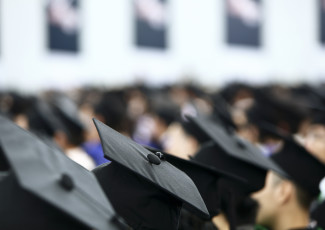Focusing on the Final 10 Percent
By AACC Staff
July 29, 2015
A commentary, “Focusing on the Final 10 Percent,” by Kevin Kruger, president of NASPA — Student Affairs Administrators in Higher Education.
This excerpted piece, by Kevin Kruger, president of NASPA — Student Affairs Administrators in Higher Education, can be accessed in full at Community College Daily, where it originally appeared.
As a nation, we are entering the final stretch of the 2020 college completion challenge announced by President Obama in his first joint address to Congress in 2009. The challenge was to have the highest proportion of college graduates in the world.
The U.S. Department of Education stated that to meet the president’s challenge, we would need the proportion of college graduates in the U.S. “to increase by 50 percent by the end of the decade. Translated into additional degree-holders, eight million more young adults will need to earn associate and bachelor’s degrees by 2020.”
The recently released American Association of Community Colleges report, “Community College Completion: Progress Toward Goal of 50% Increase,” projected that “community colleges will reach approximately 90 percent of their projected goal by 2020.” And while that achievement would be noteworthy, I’d argue that the additional 10 percent necessary to realize the total community college target is attainable if the solutions identified by innovative institutions can be scaled nationally and if student affairs professionals are included as strategy and implementation partners.
We know that community colleges face unique obstacles and challenges to closing the achievement gap among broad categories of students who are statistically least likely to graduate. The gaps associated with socioeconomic statues, gender, ethnicity, first-generation status, veteran and adult student diversity are bridgeable, but the key to successfully enrolling and supporting these students through to degree completion is building a broad institutional coalition of all those focused on the personal and academic needs of our students.
A pathway for K-12
So, what works and is scalable? Important first steps include creating a sense of belonging and then pairing students with human and financial assistance to get them through to graduation.
We must establish linkages with K-12 colleagues within our service area to develop pathway programs to address access and develop social capital among student populations who otherwise may not have considered college as a future path. For example, dual enrollment in community college while in high school allows students to think about the degree(s) and experience necessary to qualify for the jobs they want.
Many programs also arrange job shadowing to help high school students solidify the role college can play in helping them achieve their career goals. For example, Salt Lake Community College (SLCC) creates cohorts of concurrent enrollment, early college and college-level success courses in high school. Their target student populations are progressing through to graduation at promising rates.
SLCC has also implemented a tactic that our four-year college and university peers have employed for years. They, along with Maricopa Community Colleges, Tacoma Community College, Pima Community College, Edmonds Community College and many others, provide a six-week summer bridge program for their students.
These programs allow students to feel academically prepared once the fall semester begins and increase their awareness of academic and personal resources that are available across the campus. They also create cohorts of students with similar backgrounds and then provide them with the insider knowledge to succeed in college including counseling and advising, career networking, academic skills training and practical training on topics like study skills and time management.
Building relationships
These types of programs are also a great first step toward helping students find and establish relationships with faculty or staff members. The Lumina Foundation-sponsored Gallup/Purdue Index found only 22 percent of surveyed associate and bachelor’s degree holders responded they “had a mentor who encouraged me to pursue my goals and dreams.”
Yet, we know that if a student can identify a faculty or staff member who knows and cares about them they are more likely to complete their degree. If we can increase a sense of belonging and the number of students who connect and bond with faculty and staff members, then we can boost the community college completion rates closer to our aspirational range.
Once we’ve met students’ emotional and programmatic needs, we may need to help meet other short-term and sometimes low-dollar barriers to success that may exist beyond our campuses. City University of New York’s Accelerated Study in Associate Programs (ASAP) takes a holistic look at the needs of its students by providing academic, student affairs and financial support to encourage full-time enrollment for all students and specifically for those who are Pell Grant-eligible.
ASAP’s efforts include special seminars and block-scheduled classes, new approaches to developmental education, enhanced advising and career services, MetroCards for use on public transportation and use of textbooks. To date, the program has increased semester-to-semester retention, average number of credits earned over two years, and the proportion of students who earned associate degrees in two years.
Continue reading at Community College Daily.





